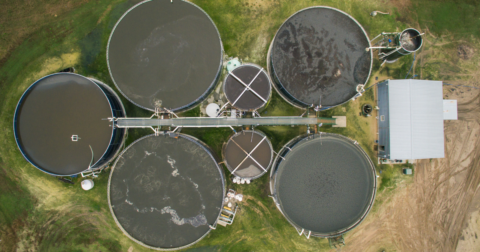Is New York City Getting its Composting Program Right?
Climate•10 min read
Explainer
A new report from the World Resources Institute finds anaerobic digesters offer limited climate benefit for a high price tag.


Words by Gaea Cabico
Livestock farms produce more than just meat and milk; they also generate massive amounts of manure — as much as 1.4 billion tons each year. Much of that waste is stored in massive lagoons until it can be applied to croplands, and the way the manure is stored fuels about nine percent of U.S. methane emissions. One technology long touted as a potential climate fix is anaerobic digestion, pitched as a way to turn all of that messy, smelly waste into clean energy. But new research from the World Resources Institute shows that though digesters produce energy — extracting methane to become biogas — they aren’t all that effective at actually tackling the methane emissions themselves.
Manure methane emissions come mostly from dairy and hog farms. The way these farms store the manure varies, with some storage solutions better at keeping the manure out of the air than others. When manure is stored in lagoons — large open ponds — it decomposes without oxygen, creating the ideal conditions for methane-producing microbes.
“What the digester does is basically covers that storage,” Swati Hegde, who researches agricultural methane production at the World Resources Institute, tells Sentient. The other promise of digesters, Hegde says: “it captures that methane and converts it into something useful.” Or that’s the idea, at least.
Manure — and sometimes food or crop waste — is fed into a sealed, oxygen-free tank called a digester. In some climates, the tank is heated slightly, which helps the naturally occurring microorganisms “work faster,” Rebecca Larson, a professor at the University of Wisconsin-Madison who studies manure management and biogas production from anaerobic digestion, tells Sentient.
Inside the digester, microbes break down the organic material. This process produces biogas — a mix of mostly methane and carbon dioxide, with small amounts of water vapor and gases like hydrogen sulfide. Carbon dioxide is then released into the atmosphere, while the methane is captured and transported through a pipe to generate electricity, heat or fuel.
Besides biogas, digesters also produce solid effluent or digested manure, which can be processed into animal bedding and compost, while the slurry can be spread on fields as fertilizer. For that to work, practically and financially, there needs to be infrastructure and a market for the bedding and fertilizer.
The number of on-farm anaerobic digester projects has exploded in the last two decades, bolstered by state and federal funding, and EPA advisory support. Digesters were embraced by meat and dairy companies — sometimes in partnership with the natural gas and biofuels industries — as a way to show these industries were taking action to reduce methane emissions.
Methane makes up 12 percent of the U.S.’s greenhouse gas emissions. Agriculture is the largest source of methane emissions, with cattle burps making up 27 percent of the total. But methane emissions from animal manure are not insignificant — coming in at around nine percent.
Digesters were touted as a way to bring that 9 percent down, and the fix sounded especially appealing because of the potential for creating a new renewable energy source.
Anaerobic digesters fare better in some ways, worse in others, according to WRI’s report.
“We should be very cautious when we actually talk about the climate benefits of a digester,” Hegde says. “It really depends on whether you are seeing it as a waste management technology or an energy generation technology,” she says. In terms of energy generation, digesters do extract methane for eventual use as natural gas, which comes with its own set of drawbacks as a fossil fuel alternative.
But when it comes to manure management, Hegde says, digesters aren’t the best option out there — reducing methane by only around 25 to 35 percent.
What kind of manure storage was there to begin with makes a difference. Anaerobic lagoons, the kind that store manure above-ground, are one of the worst ways to store manure, at least in terms of climate pollution. But deep pits and below-ground tanks like those used in some midwest pork operations keep manure methane out of the atmosphere, so a switch to an anaerobic digester from one of those methods would be worse for climate action, not better.
The kind of digester also makes a difference. Most digesters in the U.S. are only able to remove less than a third of the waste that emits methane, the researchers report. If the leftover material is then kept in open lagoons or pits where it can keep on releasing methane, the digester can only reduce methane emissions by around 25 percent. Some digesters, the kind that are more commonly used in Europe, can keep that nutrient-rich manure in the tank and out of the air for longer periods of time, which is better for reducing emissions. These covered systems can reduce methane emissions by around 35 percent, which is better than 25 percent, but there are other factors to consider.
Digesters require maintenance and oversight in order to operate safely. Sometimes things go awry, and manure spills happen — though as Larson points out, these kinds of risks are not unique to digesters.
“If you’re capturing a bunch of manure, putting it in a pit and pumping the manure itself, you already have the spill risk, and those happen with or without a digester,” she says. Some farms do not follow best practices, like using alarms or having secondary containment, Larson adds.
For digesters, there are also risks of methane leaks throughout the system — from biogas upgrading to electricity generation to flaring, which burns off excess methane and converts it to less harmful carbon dioxide. “If not done properly, even within each step of the digestion process, you can have a lot of significant emissions,” says Hegde. “So in reality, they could even be doing worse, if not done properly, than doing good.”
Digesters also produce pollutants like hydrogen sulfide, an extremely toxic gas that smells like rotten eggs. Failure to follow best practices can have serious consequences for workers. At a Seaboard Triumph Foods plant in Iowa for instance, a worker documented wafting gas, animal waste on the floor and piles of decomposed pigs.
Farms can reduce risk by installing proper ventilation systems where manure is stored, and use sensors and alarm systems that detect even small increases in hydrogen sulfide levels and increase ventilation, similar to those used in the petroleum industry, says Larson.
Ultimately, it comes down to the farm’s commitment to following proper management practices. “It takes the farm to ensure that they’re doing the training, that they understand the risk and that they’re not cutting corners in order to do things faster,” says Larson.
There are around 400 manure-based anaerobic digesters operating across the country, at least according to EPA data published a little over a year ago. More factory farms could adopt digesters, the EPA also found, reporting that more than 8,000 large dairy and hog farms could technically support biogas recovery systems.
But in addition to the climate and other limitations, digesters are expensive. Total capital costs for anaerobic digesters range from $550,000 to $6 million, with annual operating costs between $25,000 and $600,000.
“Without the subsidies, without the incentive, there is no way it works anywhere,” Hegde says. “Their climate benefits are not enough to justify the cost,” Hegde says, at least not if reducing climate pollution is your goal. “They’re very, very expensive.”
Correction: An earlier version of this story used the term “biodigester” which is more colloquial than technical. Prior to that, an previous version of this story incorrectly described the gas creates as LNG rather than biogas.